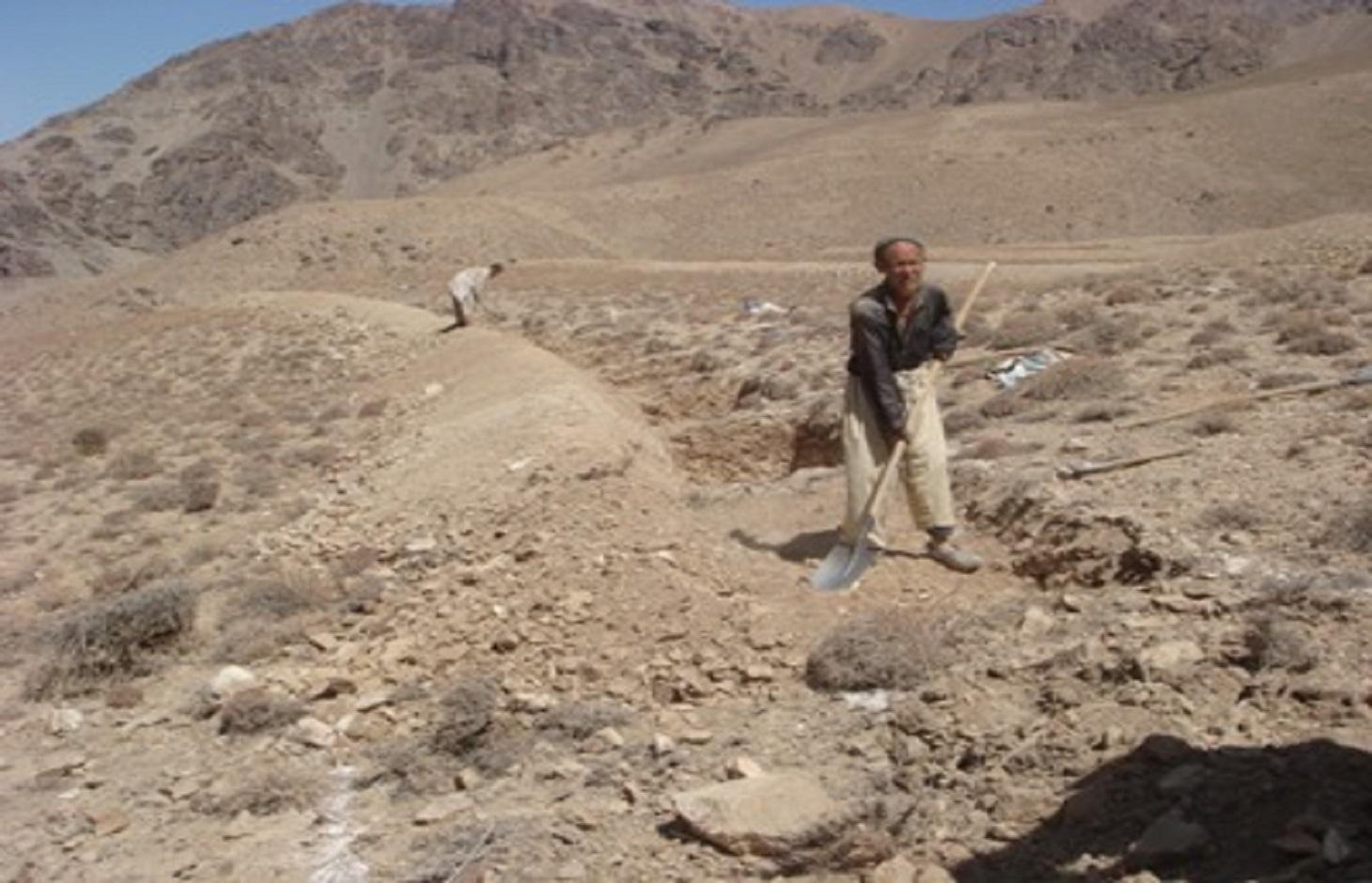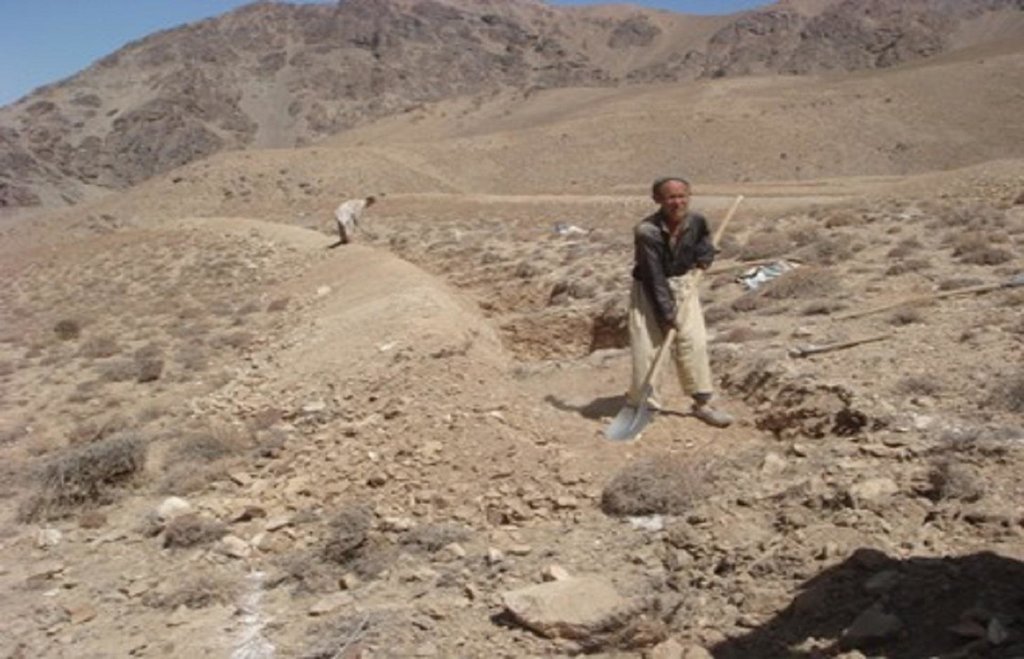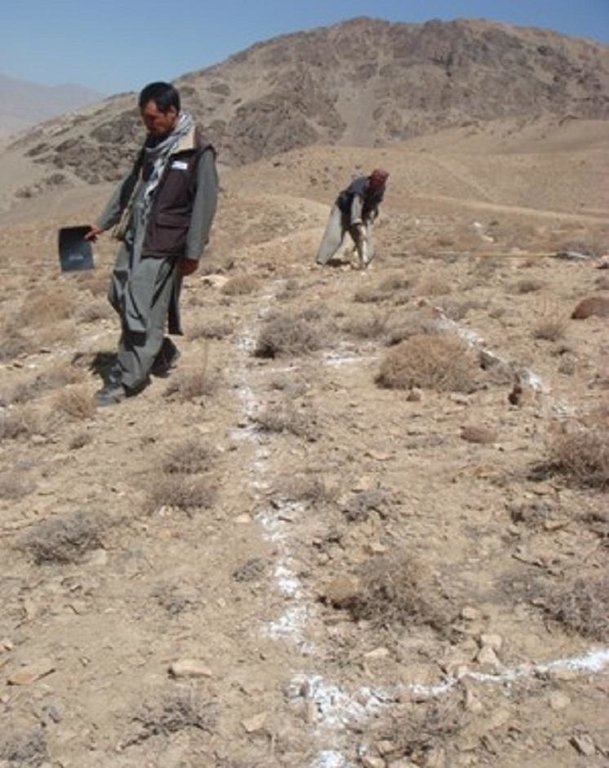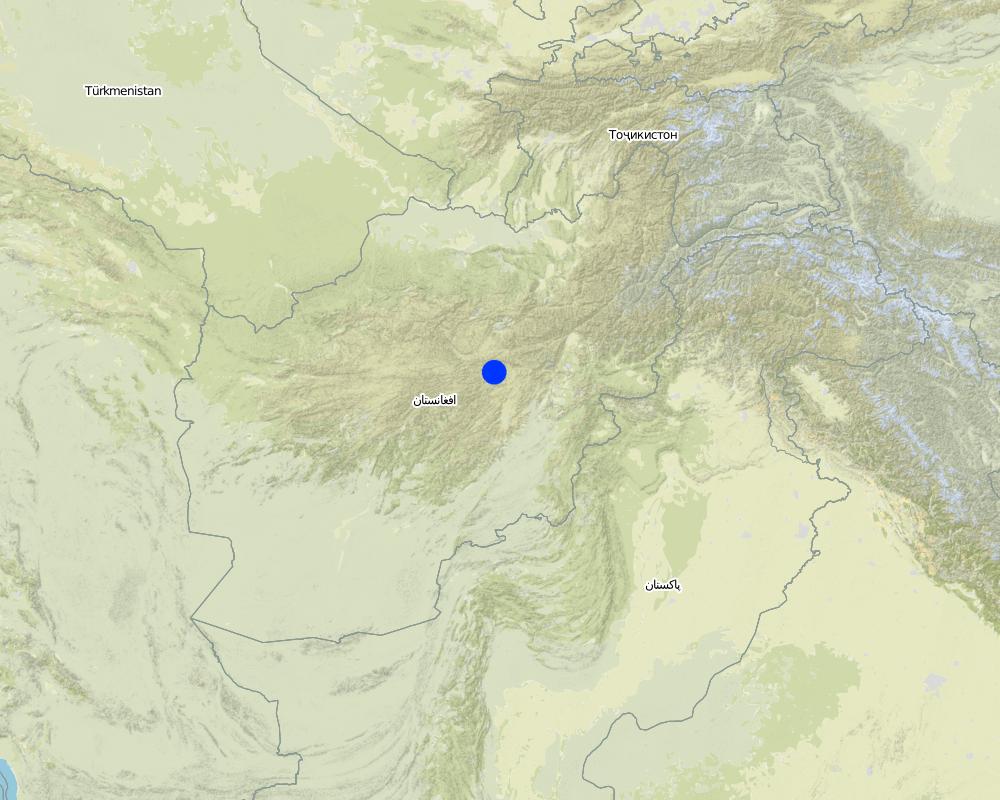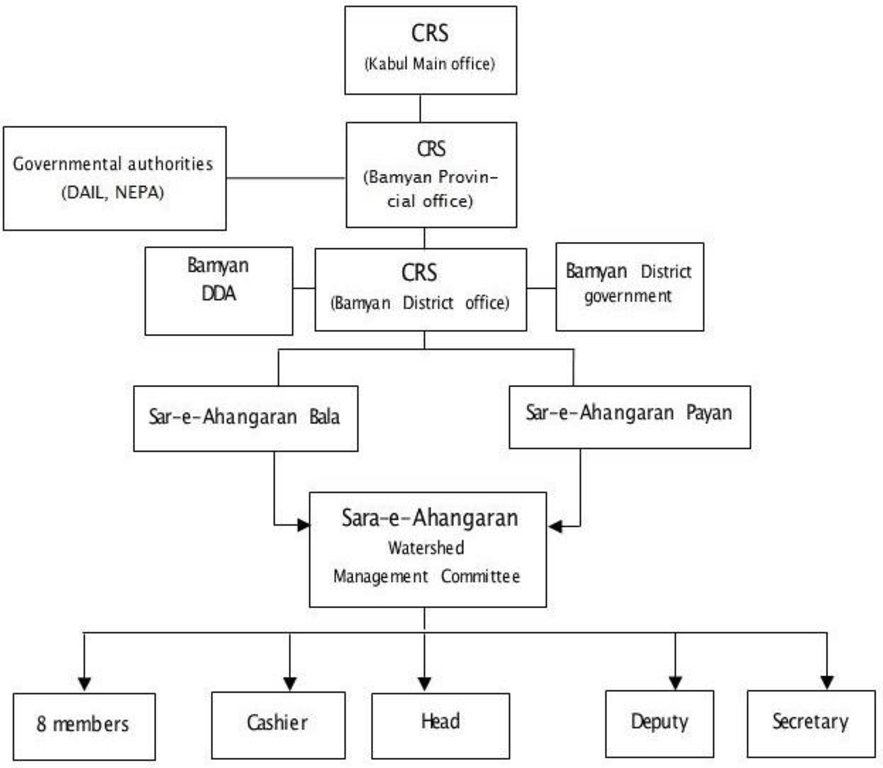Community-Based Watershed Management [ອັຟການີດສະຖານ]
- ການສ້າງ:
- ປັບປູງ:
- ຜູ້ສັງລວມຂໍ້ມູນ: Aqila Haidery
- ບັນນາທິການ: –
- ຜູ້ທົບທວນຄືນ: Deborah Niggli
Mudiriat Aabreza Tawasut Mardum (Dari)
approaches_2612 - ອັຟການີດສະຖານ
ເບິ່ງພາກສ່ວນ
ຂະຫຍາຍທັງໝົດ ຍຸບທັງໝົດ1. ຂໍ້ມູນທົ່ວໄປ
1.2 ລາຍລະອຽດ ການຕິດຕໍ່ ຂອງບຸກຄົນທີ່ຊັບພະຍາກອນ ແລະ ສະຖາບັນ ການມີສ່ວນຮ່ວມ ໃນການປະເມີນຜົນ ແລະ ເອກະສານ ຂອງວິທີທາງ
ຜູ້ຊ່ຽວຊານ ດ້ານການຄຸ້ມຄອງ ທີ່ດິນແບບຍືນຍົງ:
ຜູ້ຊ່ຽວຊານ ດ້ານການຄຸ້ມຄອງ ທີ່ດິນແບບຍືນຍົງ:
ຜູ້ຊ່ຽວຊານ ດ້ານການຄຸ້ມຄອງ ທີ່ດິນແບບຍືນຍົງ:
Montzieux Mathilde
ອັຟການີດສະຖານ
ຜູ້ຊ່ຽວຊານ ດ້ານການຄຸ້ມຄອງ ທີ່ດິນແບບຍືນຍົງ:
Hazem Zainullah
ອັຟການີດສະຖານ
ຜູ້ຊ່ຽວຊານ ດ້ານການຄຸ້ມຄອງ ທີ່ດິນແບບຍືນຍົງ:
Alemi Saadat
ອັຟການີດສະຖານ
ຜູ້ຊ່ຽວຊານ ດ້ານການຄຸ້ມຄອງ ທີ່ດິນແບບຍືນຍົງ:
Ershad Mustafa
ອັຟການີດສະຖານ
ຜູ້ຊ່ຽວຊານ ດ້ານການຄຸ້ມຄອງ ທີ່ດິນແບບຍືນຍົງ:
Ahmadi Reza
ອັຟການີດສະຖານ
ຊື່ຂອງ ສະຖາບັນການຈັດຕັ້ງ ທີ່ອໍານວຍຄວາມສະດວກ ໃນການສ້າງເອກກະສານ ຫຼື ປະເມີນແນວທາງ (ຖ້າກ່ຽວຂ້ອງ)
HELVETAS (Swiss Intercooperation)1.3 ເງື່ອນໄຂ ຂອງການນໍາໃຊ້ເອກກະສານຂໍ້ມູນ ຂອງ WOCAT
ເມື່ອໃດທີ່ໄດ້ສັງລວມຂໍ້ມູນ (ຢູ່ພາກສະໜາມ)?
10/11/2011
ຜູ້ສັງລວມ ແລະ ບັນດາຜູ້ຕອບແບບສອບຖາມ ຍອມຮັບໃນເງື່ອນໄຂ ການນໍາໃຊ້ຂໍ້ມູນເອກະສານ ທີ່ສ້າງຂື້ນ ໂດຍຜ່ານ ອົງການ WOCAT:
ແມ່ນ
1.4 ເອກະສານອ້າງອີງ (ຫຼາຍ) ກັບແບບສອບຖາມ (ຫຼາຍ) ເຕັກໂນໂລຢີ ຂອງດ້ານການຄຸ້ມຄອງ ດິນແບບຍືນຍົງ
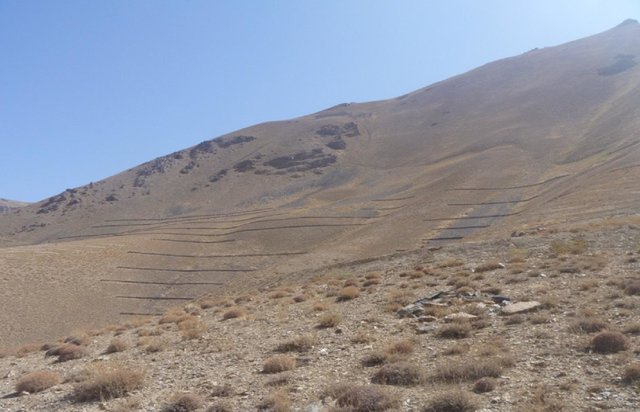
Stone wall [ອັຟການີດສະຖານ]
Contour stone walls constructed on moderate to steep slopes to retain water and sediments and trap snow.
- ຜູ້ສັງລວມຂໍ້ມູນ: Aqila Haidery
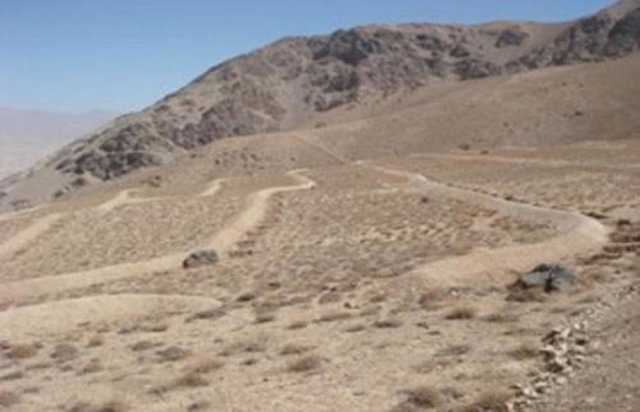
Contour Trench Bund [ອັຟການີດສະຖານ]
Contour trench bund applied on contour lines of moderate slope to trap run-off to improve infiltration and reduce flash floods.
- ຜູ້ສັງລວມຂໍ້ມູນ: Aqila Haidery
2. ພັນລະນາ ແນວທາງການຄຸ້ມຄອງນໍາໃຊ້ດິນແບບຍືນຍົງ
2.1 ການອະທິບາຍ ໂດຍຫຍໍ້ ຂອງວິທີທາງ
Sustainable implementation of watershed management through appropriate SLM technologies, formation of organizational structures and capacity building of stakeholders
2.2 ການອະທິບາຍ ລາຍລະອຽດ ຂອງວິທີທາງ
ການອະທິບາຍ ລາຍລະອຽດ ຂອງວິທີທາງ:
The overall objective of the community-based watershed management project implemented at Sar-e-Ahangaran was to reduce water induced disaster risks and improve people’s livelihoods. The project was implemented by Catholic Relief Services (CRS) with people’s support and funding assistance from USAID.
About 67 hectares of degraded land has been rehabilitated since 2009 through various soil and water conservation measures like stone walls, contour trenches and plantation of fodder species such as alfalfa. The local communities are also protecting the treated areas from grazing and shrub cutting.
With facilitation from CRS, a 15-member watershed management committee was appointed by the participating families. This was important for organizing watershed related works and for the sustainability of project interventions. Some rules for managing the selected watershed were also formulated in a participatory way. For instance, if anyone is found grazing animals at the site, he has to give one sheep to the watershed committee as a fine.
CRS has provided training and technical support to the watershed committee members and workers for project implementation and monitoring. The daily workers were selected from the local communities by the watershed committee and paid in cash as per national norms for their labor. CRS also organized awareness raising workshops regarding environmental conservation and water-shed management and the entire community including teachers and students participated in these village events.
As a result of Sar-e-Ahangaran watershed management project, the people have a more positive attitude towards natural resource management. The formation and capacity building of the watershed management committee is a step towards ensuring long-term sustainability of the project outputs and community owner-ship. The watershed committee is not yet registered with the government but for future sustainability, this will be an important activity. The Islamic Republic of Afghanistan is in the process of formulating a comprehensive community-based natural resource management strategy. Once in place, the Sar-e-Ahangaran community can take advantage of that strategy if the watershed committee is formally registered with the Ministry of Agriculture, Irrigation and Livestock (Bamyan).
The Community-Based Watershed Management approach is documented by Sustainable Land Management Project /HELVETAS Swiss Intercooperation which is funded by Swiss Agency for Development and Cooperation with close support and cooperation of the Catholic Relief Service (CRS).
2.3 ຮູບພາບຂອງແນວທາງ
2.5 ປະເທດ / ເຂດ / ສະຖານທີ່ບ່ອນທີ່ແນວທາງໄດ້ຖືກນໍາໃຊ້
ປະເທດ:
ອັຟການີດສະຖານ
ພາກພື້ນ / ລັດ / ແຂວງ:
Bamyan
ຂໍ້ມູນເພີ່ມເຕີມຂອງສະຖານທີ່:
Sar-e-Ahangaran, Bamyan center
Map
×2.6 ວັນທີເລີ່ມຕົ້ນ ແລະ ສິ້ນສຸດ ການຈັດຕັ້ງປະຕີບັດ ວິທີທາງ
ສະແດງປີຂອງການເລີ່ມຕົ້ນ:
2009
2.7 ປະເພດຂອງແນວທາງ
- ພາຍໃຕ້ໂຄງການ / ແຜນງານ
2.8 ເປົ້າໝາຍ / ຈຸດປະສົງຫຼັກ ຂອງການຈັດຕັ້ງປະຕິບັດ ວິທີທາງ
The Approach focused mainly on SLM with other activities (Disaster Risk Reduction, Rural Livelihoods Improvement)
The overall objective of the project was to reduce watershed induced disaster risks and improve rural livelihoods through SLM technologies and community based sustainable approaches
The SLM Approach addressed the following problems: Lack of people’s knowledge regarding sustainable management of natural resources and disaster risk reduction, lack of knowledge, technical and organisational capacities on sustainable land management technologies for degraded lands
2.9 ເງື່ອນໄຂອໍານວຍ ຫຼື ຂັດຂວາງການປະຕິບັດຂອງເຕັກໂນໂລຢີ / ເຕັກໂນໂລຢີການນໍາໃຊ້ຕາມແນວທາງ
ສັງຄົມ / ວັດທະນະທໍາ / ມາດຕະຖານ ແລະ ຄຸນຄ່າທາງສາສະໜາ
- ເຊື່ອງຊ້ອນ
People did not have a good idea about how to conserve the environment and at the same time reduce disaster risks and improve their livelihoods
Treatment through the SLM Approach: Training and education via sharing knowledge with watershed committees in Waras forming maintenance committees who should look after restrictions about grazing. Practical demonstration of potential SLM technologies
ມີຄວາມສາມາດ / ເຂັ້າເຖິງຊັບພະຍາກອນດ້ານການເງິນ ແລະ ການບໍລິການ
- ເຊື່ອງຊ້ອນ
People do not have financial capacities
Treatment through the SLM Approach: Project had a Cash for Work but learning approach
ກ່ຽວກັບກົດໝາຍ (ສິດນໍາໃຊ້ດິນ, ສິດນໍາໃຊ້ນໍ້າ)
- ເຊື່ອງຊ້ອນ
As the land is formally owned by the government, people did not invest much in sustainable practices. During project initiation, people were also sceptical and rejected the project idea as they thought that by digging trenches, the project was trying to search for gold
Treatment through the SLM Approach: Through several discussions and clarifications and by assurances from the government, people were convinced that the project had no hidden motives and gradually their trust in CRS increased
ຄວາມຮູ້ກ່ຽວກັບການຄຸ້ມຄອງ ທີ່ດິນແບບຍືນຍົງ, ການເຂົ້າເຖິງການສະໜັບສະໜູນ ທາງດ້ານວິຊາການ
- ເຊື່ອງຊ້ອນ
Lack of knowledge about SLM measures
Treatment through the SLM Approach: Training and technical support from CRS
3. ການມີສ່ວນຮ່ວມ ແລະ ບົດບາດຂອງພາກສ່ວນທີ່ກ່ຽວຂ້ອງທີ່ໄດ້ມີສ່ວນຮ່ວມ
3.1 ຜູ້ມີສ່ວນຮ່ວມ ໃນວິທີທາງ ແລະ ພາລະບົດບາດ ຂອງເຂົາເຈົ້າ
- ຜູ້ນໍາໃຊ້ດິນໃນທ້ອງຖິ່ນ / ຊຸມຊົນທ້ອງຖິ່ນ
- ອົງການຈັດຕັ້ງ ພາຍໃນຊຸມຊົນ
3.2 ການມີສ່ວນຮ່ວມຂອງຜູ້ນໍາໃຊ້ທີ່ດິນໃນທ້ອງຖິ່ນ / ຊຸມຊົນທ້ອງຖິ່ນໃນໄລຍະທີ່ແຕກຕ່າງກັນຂອງແນວທາງ
| ການລວບລວມ ເອົາຜູ້ນໍາໃຊ້ດິນ ໃນທ້ອງຖິ່ນ / ຊຸມຊົນທ້ອງຖິ່ນ | ໃຫ້ລະບຸ ຜູ້ໃດທີ່ມີສ່ວນຮ່ວມ ໃນແຕ່ລະກິດຈະກໍາ? | |
|---|---|---|
| ການເລີ່ມຕົ້ນ / ແຮງຈູງໃຈ | ການຮ່ວມມື | CRS discussed land use problems and formulated the project. Project site was selected by the participating families and respective CDCs |
| ການວາງແຜນ | ການຮ່ວມມື | CDC and watershed members were involved in the planning but not the whole community |
| ການປະຕິບັດ | ການຊ່ວຍເຫຼືອຈາກພາຍນອກ | Implementation was by the local communities with cash for work approach |
| ຕິດຕາມກວດກາ / ການປະເມີນຜົນ | ການນໍາໃໍຊ້ເອງ | Voluntary monitoring group to look after the environment. Also joint monitoring by project stakeholders |
| Research | ການບໍ່ປະຕິບັດ |
3.3 ແຜນວາດ (ຖ້າມີ)
ການອະທິບາຍ:
The organizational Chart of Sar-e_Ahangaran Watershed Management Committee
ຜູ້ຂຽນ:
Catholic Relief Service (CRS)
3.4 ການຕັດສິນໃຈກ່ຽວກັບການຄັດເລືອກເຕັກໂນໂລຢີຂອງການຄຸ້ມຄອງທີ່ດິນແບບຍືນຍົງ / ເຕັກໂນໂລຢີ
ລະບຸ ຄົນທີ່ຕັດສິນໃຈ ກ່ຽວກັບການຄັດເລືອກຂອງ ເຕັກໂນໂລຢີ / ເຕັກໂນໂລຢີ ຈະໄດ້ຮັບການປະຕິບັດ:
- ຜູ້ຊ່ຽວຊານ ຫຼັກດ້ານການຄຸ້ມຄອງ ທີ່ດິນແບບຍືນຍົງ, ມີການຕິດຕາມປຶກສາຫາລືກັບຜູ້ນໍາໃຊ້ທີ່ດິນ
ອະທິບາຍ:
The area was selected by the community
Decisions on the method of implementing the SLM Technology were made by mainly by SLM specialists with consultation of land users. However, workers were selected by the watershed committee members in consultation with their community development councils (CDCs).
4. ການສະໜັບສະໜູນທາງດ້ານວິຊາການ, ການສ້າງຄວາມສາມາດ, ແລະ ການຈັດການຄວາມຮູ້.
4.1 ການສ້າງຄວາມສາມາດ / ການຝຶກອົບຮົມ
ຜູ້ນໍາໃຊ້ທີ່ດິນ ຫຼື ພາກສ່ວນກ່ຽວຂ້ອງອື່ນໆ ໄດ້ຮັບການຝຶກອົບຮົມບໍ່?
ແມ່ນ
ໃຫ້ລະບຸ ຜູ້ໃດທີ່ໄດ້ຮັບການຝຶກອົບຮົມ:
- ຜູ້ນໍາໃຊ້ດິນ
- Project field officers, Land users, CDC and Watershed Management Committee members, teacher and students, both women and men
ຮູບແບບຂອງການຝຶກອົບຮົມ:
- ການເຮັດຕົວຈິງ
- ຕົວຕໍ່ຕົວ
ຮູບແບບຂອງການຝຶກອົບຮົມ:
- organizing courses
ໃນຫົວຂໍ້:
contour trench and stone wall technologies, tree planting, importance of pasture management and watershed management
4.2 ການບໍລິການໃຫ້ຄໍາປຶກສາ
ເຮັດຜູ້ໃຊ້ທີ່ດິນມີການເຂົ້າເຖິງການບໍລິການໃຫ້ຄໍາປຶກສາ?
ແມ່ນ
ອະທິບາຍ / ຄວາມຄິດເຫັນ:
CRS provided continuous advice; Key elements: increase awareness by forming a watershed committee, technical support of the committee
Advisory service is inadequate to ensure the continuation of land conservation activities; The government or other advisory service is still inadequate to ensure the continuation of land conservation activities. The government authorities visited the project only once, at the end of the project. They did not provide much support; however, as the land belongs formally to the state, they did not have any objections for applying watershed management measures.
4.3 ສະຖາບັນການສ້າງຄວາມເຂັ້ມແຂງ (ການພັດທະນາອົງການຈັດຕັ້ງ)
ສະຖາບັນ ໄດ້ຮັບການສ້າງຕັ້ງຂື້ນ ຫຼື ໄດ້ຮັບການສ້າງຄວາມເຂັ້ມແຂງ ໂດຍການຈັດຕັ້ງປະຕິບັດ ວິທີທາງບໍ່?
- ມີ, ພໍສົມຄວນ
ລະບຸ ທາງສະຖາບັນ ໄດ້ສ້າງຄວາມເຂັ້ມແຂງ ໃນລະດັບໃດ (ຫຼາຍ):
- ທ້ອງຖິ່ນ
ໃຫ້ລາຍລະອຽດເພີ່ມເຕີມ:
CDCs and watershed management committees. Schools teachers and students also received training
4.4 ຕິດຕາມກວດກາ ແລະ ປະເມີນຜົນ
ການຈັດຕັ້ງປະຕິບັດ ວິທີທາງ ໄດ້ມີການປະເມີນຜົນ ແລະ ຕິດຕາມບໍ?
ແມ່ນ
ຄວາມຄິດເຫັນ:
bio-physical aspects were regular monitored by project staff through measurements; indicators: Water quality and quantitative measurements
technical aspects were ad hoc monitored by project staff, land users, other through observations; indicators: ad hoc field visits and monitoring of structural quality
socio-cultural aspects were ad hoc monitored by project staff through measurements; indicators: Hosuehold survey
economic / production aspects were ad hoc monitored by project staff through measurements; indicators: Household survey
area treated aspects were ad hoc monitored by project staff through observations; indicators: Other areas where technology has been applied
no. of land users involved aspects were regular monitored by land users through measurements; indicators: Selecting the beneficiaries
management of Approach aspects were None monitored by land users through observations; indicators: Monitoring the community which looks after the pasture management
There were few changes in the Approach as a result of monitoring and evaluation: especially with regard to organisational structure for monitoring works
4.5 ການຄົ້ນຄວ້າ
ນີ້້ແມ່ນສ່ວນໜຶ່ງ ການຄົ້ນຄວ້າ ຂອງວິທີທາງບໍ່?
ແມ່ນ
- Farm research
ໃຫ້ຂໍ້ມູນ ເພີ່ມເຕີມ ແລະ ກໍານົດ ຜູ້ໃດເຮັດການຄົ້ນຄວ້າ:
Topics included technology functions, vegetation status before and after project, monitoring of spring (located below) water quality and quantity.
5. ການສະໜັບສະໜູນທາງດ້ານການເງິນ ແລະ ອຸປະກອນຈາກພາຍນອກ
5.1 ງົບປະມານປະຈໍາປີ ສໍາລັບວິທີທາງ ຂອງການຄຸ້ມຄອງ ທີ່ດິນແບບຍືນຍົງ
ຖ້າຫາກບໍ່ຮູ້ຈັດງົບປະມານທີ່ແນ່ນອນ ແມ່ນໃຫ້ປະມານເອົາ:
- 10,000-100,000
ຄໍາເຫັນ (ຕົວຢ່າງ: ແຫຼ່ງຂໍ້ມູນຫຼັກ ຂອງການສະໜອງທຶນ / ຜູ້ໃຫ້ທຶນທີ່ສໍາຄັນ):
Approach costs were met by the following donors: international non-government: 99.0%; local community / land user(s): 1.0%
5.2 ການສະໜັບສະໜູນ ທາງດ້ານການເງິນ / ອຸປະກອນ ສະໜອງໃຫ້ແກ່ຜູ້ນໍາທີ່ດິນ
ຜູ້ນໍາໃຊ້ດິນ ໄດ້ຮັບການສະໜັບສະໜູນ ທາງດ້ານ ການເງິນ / ອຸປະກອນ ໃນການຈັດຕັ້ງປະຕິບັດ ເຕັກໂນໂລຢີບໍ?
ບໍ່ແມ່ນ
5.4 ສິນເຊື່ອ
ໄດ້ປ່ອຍສິນເຊື່ອ ສະໜອງໃຫ້ພາຍໃຕ້ ວິທີການສໍາລັບກິດຈະກໍາ ການຄຸ້ມຄອງ ທີ່ດິນແບບຍືນນຍົງບໍ່?
ບໍ່ແມ່ນ
5.5 ສິ່ງຈູງໃຈ ຫຼື ເຄື່ອງມືອື່ນໆ
ການສົ່ງເສີມ ຈັດຕັ້ງປະຕິບັດ ເຕັກໂນໂລຢີ ໃນການຄຸ້ມຄອງ ດິນແບບຍືນຍົງ ໄດ້ສະໜອງສິ່ງກະຕຸກຊຸກຍູ້ບໍ່?
ບໍ່ແມ່ນ
6. ວິເຄາະຜົນກະທົບ ແລະ ສັງລວມບັນຫາ
6.1 ຜົນກະທົບຂອງແນວທາງ
ການຈັດຕັ້ງປະຕິບັດ ວິທີທາງ ສາມາດຊ່ວຍຜູ້ນໍາໃຊ້ທີ່ດິນ ໃນການຈັດຕັ້ງປະຕິບັດ ແລະ ບໍາລຸງຮັກສາ ເຕັກໂນໂລຢີ ການຄຸ້ມຄອງ ທີ່ດິນແບບຍືນຍົງໄດ້ບໍ?
- ບໍ່
- ມີ, ໜ້ອຍໜຶ່ງ
- ມີ, ພໍສົມຄວນ
- ມີ, ຫຼາຍ
Land cover by vegetation improved significantly. Flash floods and snow avalanche problems were reduced, and the community members were more aware about the technologies and approaches for sustainable land management.
ການຈັດຕັ້ງປະຕິບັດ ວິທີທາງ ສາມາດສ້າງຄວາມເຂັ້ມແຂງ ທາງສັງຄົມ ແລະ ເສດຖະກິດບໍ່?
- ບໍ່
- ມີ, ໜ້ອຍໜຶ່ງ
- ມີ, ພໍສົມຄວນ
- ມີ, ຫຼາຍ
People got cash for work and some of the families could pay back their loans through this income.
The land belongs to the state and the water use right is as well open access and and organized manner. In this particular land land use problem or water use problems have not been seen.
Did other land users / projects adopt the Approach?
- ບໍ່
- ມີ, ໜ້ອຍໜຶ່ງ
- ມີ, ພໍສົມຄວນ
- ມີ, ຫຼາຍ
There were constraints from the people in the beginning. Now a similar approach with some modifications is being implemented in other watersheds as well as a result of this project.
Did the Approach lead to improved livelihoods / human well-being?
- ບໍ່
- ມີ, ໜ້ອຍໜຶ່ງ
- ມີ, ພໍສົມຄວນ
- ມີ, ຫຼາຍ
They got more money via the cash for work; however, there is no impact for the livestock because the pasture area is big enough.
Did the Approach help to alleviate poverty?
- ບໍ່
- ມີ, ໜ້ອຍໜຶ່ງ
- ມີ, ພໍສົມຄວນ
- ມີ, ຫຼາຍ
due to cash for work approach and increased production of wheat, potato and other agricultural products as a result of reduced flood risks
6.2 ແຮງຈູງໃຈຫຼັກຂອງຜູ້ນໍາໃຊ້ທີ່ດິນໃນການປະຕິບັດການຄຸ້ມຄອງທີ່ດິນແບບຍືນຍົງ
- ກໍາໄລເພີ່ມຂຶ້ນ (ຄວາມສາມາດ), ການປັບປຸງຄ່າໃຊ້ຈ່າຍ, ຜົນປະໂຫຍດ, ອັດຕາສ່ວນ
- ກົດລະບຽບແລະລະບຽບການ (ລະອຽດ) / ການບັງຄັບໃຊ້
- to get employed through cash for work
- reduce flood risks
- Understand the importance of watershed
- Understand the importance of NRM
- Ownership of the project activities
6.3 ຄວາມຍືນຍົງຂອງກິດຈະກໍາວິທີທາງ
ຜູ້ນໍາໃຊ້ ທີ່ດິນ ສາມາດສືບຕໍ່ ການຈັດຕັ້ງປະຕິບັດ ຜ່ານວິທີທາງໄດ້ບໍ່ (ໂດຍປາດສະຈາກ ການຊ່ວຍເຫຼືອ ຈາກພາກສ່ວນພາຍນອກ)?
- ບໍ່ແນ່ນອນ
ຖ້າ ບໍ່ ຫຼື ບໍ່ແນ່ໃຈ, ໃຫ້ອະທິບາຍ ແລະ ຄໍາເຫັນ:
but CRS continues to build capacities of watershed committees and support plantation of fodder species so that people get direct benefits and the project is sustained.
6.4 ຈຸດແຂງ / ຂໍ້ດີ ຂອງວິທີທາງ
| ຈຸດແຂງ / ຈຸດດີ / ໂອກາດ ຈາກທັດສະນະຂອງຜູ້ປ້ອນຂໍ້ມູນ ຫຼື ບຸກຄົນສຳຄັນ |
|---|
| Less damage to some agricultural land located below the watershed sites due to flash floods |
| Prevention of snow slide |
| Increased water in the spring |
| Plant coverage of the area increased |
| Prevention from soil erosion |
6.5 ຈຸດອ່ອນ / ຂໍ້ເສຍຂອງແນວທາງ ແລະ ວິທີການແກ້ໄຂໃຫ້ເຂົາເຈົ້າ
| ຈຸດອ່ອນ ຫຼື ຂໍ້ເສຍ ຫຼື ຄວາມສ່ຽງ ໃນມຸມມອງຂອງ ຜູ້ສັງລວມຂໍ້ມູນ ຫຼື ບັນດາຜູ້ຕອບແບບສອບຖາມ | ມີວິທີການແກ້ໄຂຄືແນວໃດ? |
|---|---|
| Watershed management committee is not registered | CRS should facilitate registration of the committee with the Department of Agriculture, Irrigation and Livestock in Bamyan |
| People are not taking care of the plantations | People must understand the importance of plantations. The project should figure out the reasons why people are not interested in plantation activities and adjust approaches accordingly |
7. ເອກກະສານອ້າງອີງ ແລະ ຂໍ້ມູນການເຊື່ອມໂຍງ
7.1 ວິທີການ / ແຫຼ່ງຂໍ້ມູນ
- ການໄປຢ້ຽມຢາມພາກສະໜາມ, ການສໍາຫຼວດພາກສະໜາມ
- ການສໍາພາດ ຜູ້ນໍາໃຊ້ທີ່ດິນ
ຂໍ້ມູນການເຊື່ອມຕໍ່ ແລະ ເນື້ອໃນ
ຂະຫຍາຍທັງໝົດ ຍຸບທັງໝົດການເຊື່ອມຕໍ່

Stone wall [ອັຟການີດສະຖານ]
Contour stone walls constructed on moderate to steep slopes to retain water and sediments and trap snow.
- ຜູ້ສັງລວມຂໍ້ມູນ: Aqila Haidery

Contour Trench Bund [ອັຟການີດສະຖານ]
Contour trench bund applied on contour lines of moderate slope to trap run-off to improve infiltration and reduce flash floods.
- ຜູ້ສັງລວມຂໍ້ມູນ: Aqila Haidery
ເນື້ອໃນ
ບໍ່ມີເນື້ອໃນ


